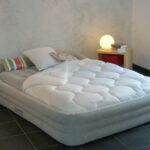How and how to glue an inflatable mattress at home
An inflatable mattress is convenient both for trips to nature and for creating a sleeping place for a guest to spend the night. However, the design of any large inflatable product makes it vulnerable to punctures and severe cuts from sharp objects. Sometimes it is extremely difficult to identify a micro puncture. Air through an inconspicuous hole can leak out little by little, making it impossible to visually determine the location of the damage. The different nature of the damage requires an understanding of how and what is the best way to glue a punched air mattress during home repairs.

How to find a hole or puncture
Craftsman's ingenuity tells owners of damaged mattresses the following ways to detect a puncture:
- Search for the place of penetration by ear.
- Water use.
- The use of soap solutions.
- Valve Integrity Test Using Shaving Foam.
- Sprinkle with starch.
- Wrapping the surface of the mattress with cling film.
Each detection method will be discussed separately below.
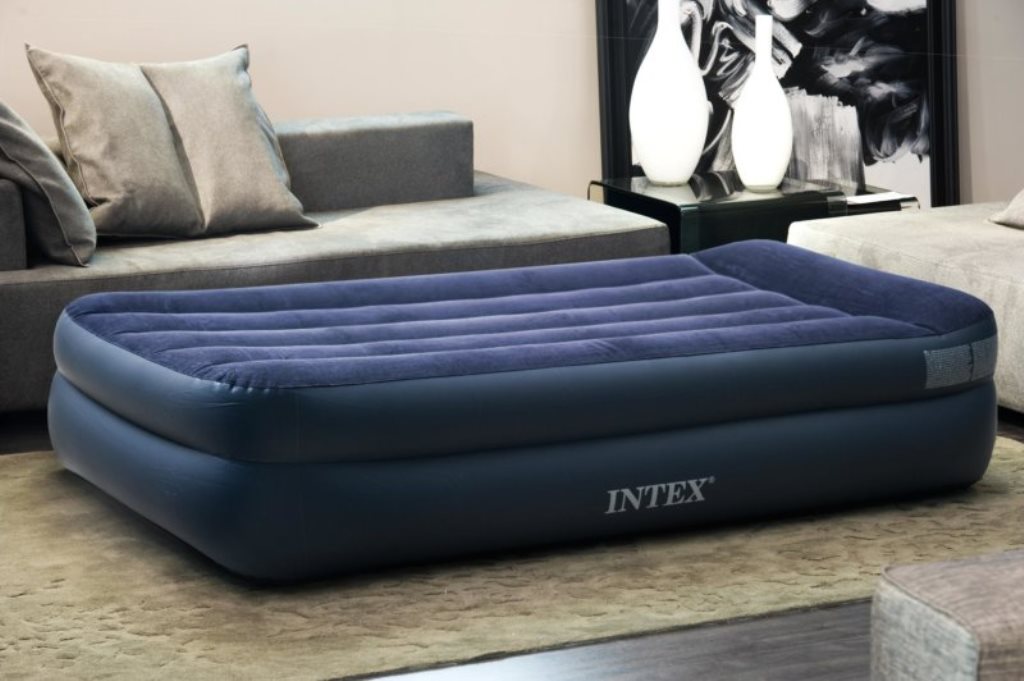
Aurally
With a sufficiently large penetration, the outgoing air is capable of emitting a characteristic whistle. To amplify the sound, it is recommended to lightly press down on the surface of the inflated mattress to be examined. Pressing with your hand near the puncture site significantly increases the whistle, allowing you to find an inconspicuous hole. If there are several penetrations on the surface, then the search may become more difficult. In this case, it is worth trying other ways to detect damage.

With water
Water can indicate damage in two ways: by immersing an inflated mattress in water and flooding its inner compartments. The first method is inconvenient and not always appropriate. Bathrooms in apartments are not suitable for full immersion of the mattress in water. And pools and ponds are not always within reach. Therefore, water is most often used to fill the compartments of the mattress. To do this, it is recommended to perform the following actions:
- Pour 3-5 liters of water into the mattress through the inflatable valve.
- Close the valve and wipe the mattress from possible drops that accidentally fall on the outer surface.
- Twist and shake the mattress. A portion of the water should go through all of its compartments. Press down on the surface of the mattress (you can just lie on top). The air blown out under pressure will carry moisture along with it.
- Examine the mattress. At the site of the penetration, phlegm should appear.
- Mark the puncture site with a marker. Drain the water.
- Blow out moisture from the compartments of the mattress using several cycles, inflating and bleeding air.

Important! Do not glue the hole if there is phlegm on the surface. The presence of a humid environment in the compartments is also undesirable.
Soapy solution
The method of applying a soap solution involves a step-by-step search for damage on the surface of the mattress. The solution is applied to a portion of the inflated mattress and inspected for bubbles on the treated surface.After that, it is applied to the adjacent area. To enhance the effect, the mattress is pressed down on top. All detected punctures are marked. A good hole finder solution can be made with liquid soap, shampoo, and a mild dishwashing liquid.
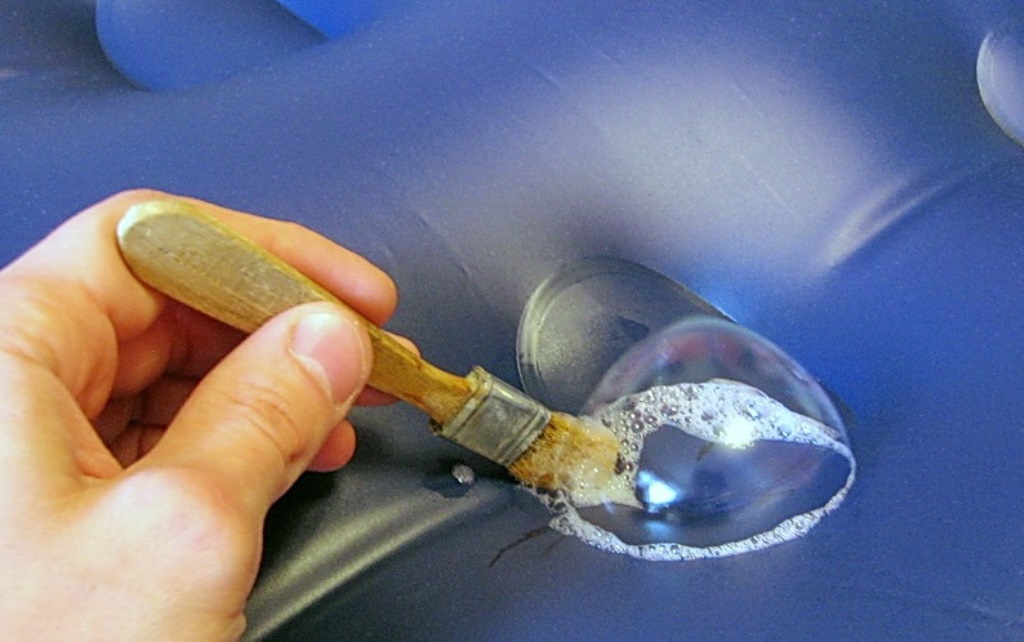
Important! It is not allowed to use detergents and corrosive liquids as a material for the solution. They also cannot be used to clean the mattress. This can lead to the formation of microdamages, which eventually grow into full-fledged holes.
Shaving foam
This method is too expensive to be applied all over the mattress. But it is ideal for locating punctures and delamination near the valve. The foam is applied in a small layer around the closed valve and bubbles are found at the blowing point.

Starch
Starch is a fine powder that creates a small cloud when air is blown out from below. During application, windows and doors must be closed and air conditioning in the room suspended. A draft can destroy all efforts. The sprinkling of the surface occurs in stages. The boundaries of the studied areas are marked with a pencil. Instead of starch, you can use flour, powder, baby powder or soda. When using baking soda, after processing, carefully remove the powder layer with a vacuum cleaner and wipe the surface with a dry cloth. The free-flowing method is convenient in that it does not require subsequent drying for repair.

Cling film
When going out into nature, an unsuccessfully placed mattress on the ground can receive many micro-punctures. For large-scale sealing it is necessary to quickly find all the holes. All of the above methods, although economical, but in such cases will take a lot of time to find and mark damage. The method of covering the wetted surface makes it possible to immediately identify the places of multiple penetrations. To do this, you need to take the following steps:
- Inflate the mattress and then pump it up, not allowing it to go down too much.
- Moisten the surface by wetting or spraying with water. There should be no dry areas on the mattress.
- Cover the entire mattress in one layer with thin cling film. With excessive relief of the sleeping part, such areas are fitted separately, by densely overlaying strips of film.
- Pump air into the compartments as much as possible through the valve. Press the entire mattress with your hands.
- Carefully cut the film and mark the puncture sites.

How to glue an air mattress
Having determined the location and nature of the damage, it is necessary to choose how and what to glue the mattress with. Sleeping products are factory-equipped with a spare set of vinyl for patches and a tube of special glue. When the repair "spare" is used up, materials and adhesives will have to be selected independently. From tools, the DIYer will need a glue brush, fine-grained sandpaper, and scissors with durable blades. You will also need a weight to press down on the sealed patch.
Adhesive selection
The correct adhesive is a prerequisite for the durability of the repaired area of the air mattress. The adhesive must meet the following requirements:
- The adhesive must be compatible with the material to be bonded. The rubber glue holds the rubber together well. The PVC tube is suitable for bonding flexible PVC surfaces. Shoe (polyurethane) glue is suitable for patches made of rubber, leather, PVC and thermoplastic elastomers (TPE). "Universal moment" is suitable for any elastic patch.But its coarser analogue "Super Moment 1" is not able to create high-quality and long-term adhesion (it is destroyed under air pressure). The materials from which the inflatable mattress is made are usually indicated in the instructions for use.
- The glue must be waterproof. Even if the mattress is not intended to be used near the sea, the sealed seam is exposed to high humidity in the living area. The air in the house is constantly humidified by the kitchen, bath, toilet, watering flowers.
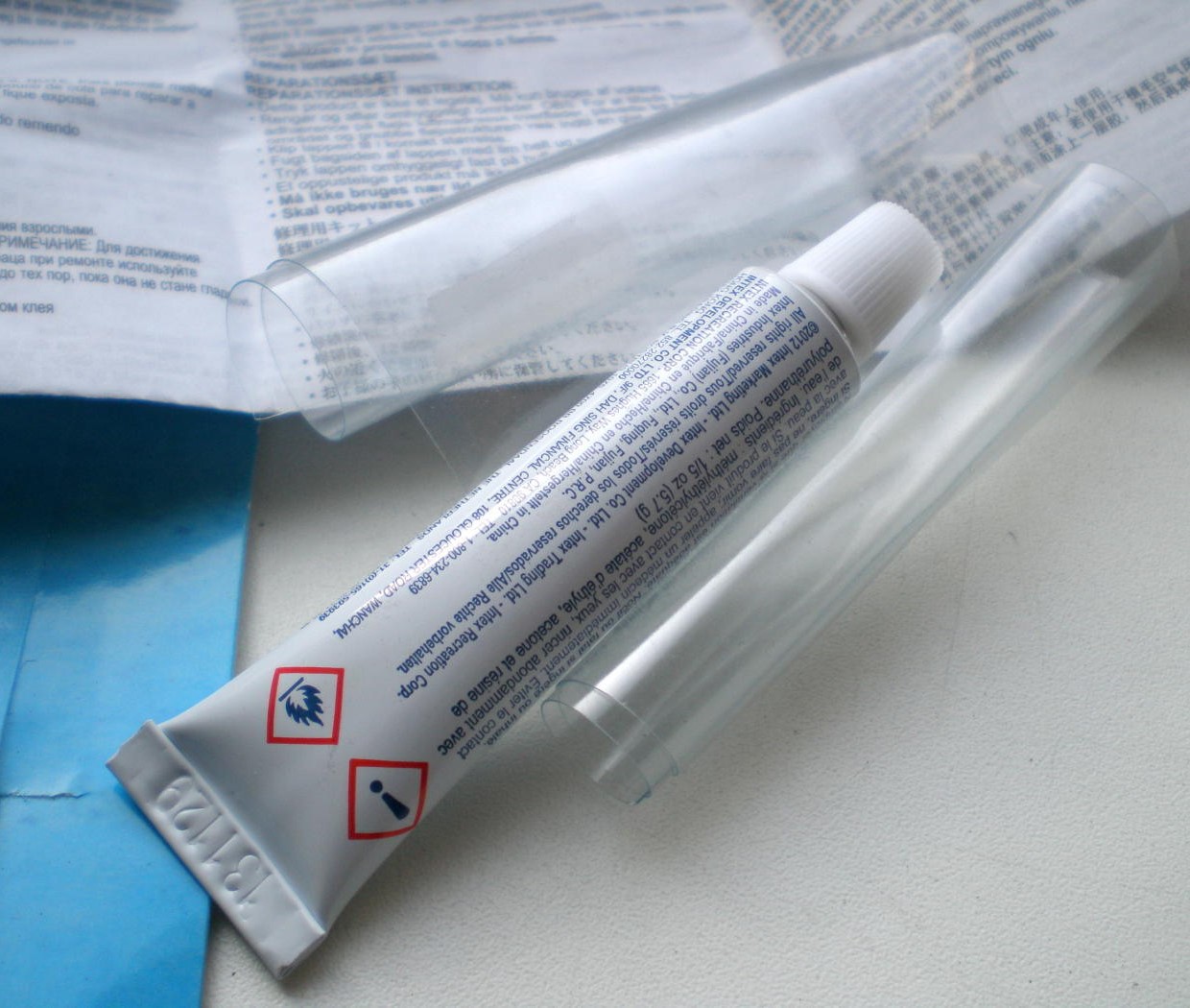
Surface bonding
For proper adhesion, it is not enough just to dry and clean the surface of the mattress. Preparation for gluing any surfaces begins with their obligatory degreasing. The destruction of this organic layer, which is invisible to the eye, is carried out with the help of alcohol. The alcohol itself evaporates very quickly from the surface. Micro-protrusions along the edges of the punctures are leveled by briefly rubbing the area with a hole with sandpaper.

At the preparatory stage, it is also important to pay attention to the creation of the patch. The material of the patch should be airtight, moisture resistant and elastic. The optimal geometry for the patch is a circle or oval. Squares and triangles begin to flake off from the corners over time. The edges of the patch should completely cover the hole, with a margin of at least 2 cm at either end. The same rule applies in cases where one patch covers several punctures at once.
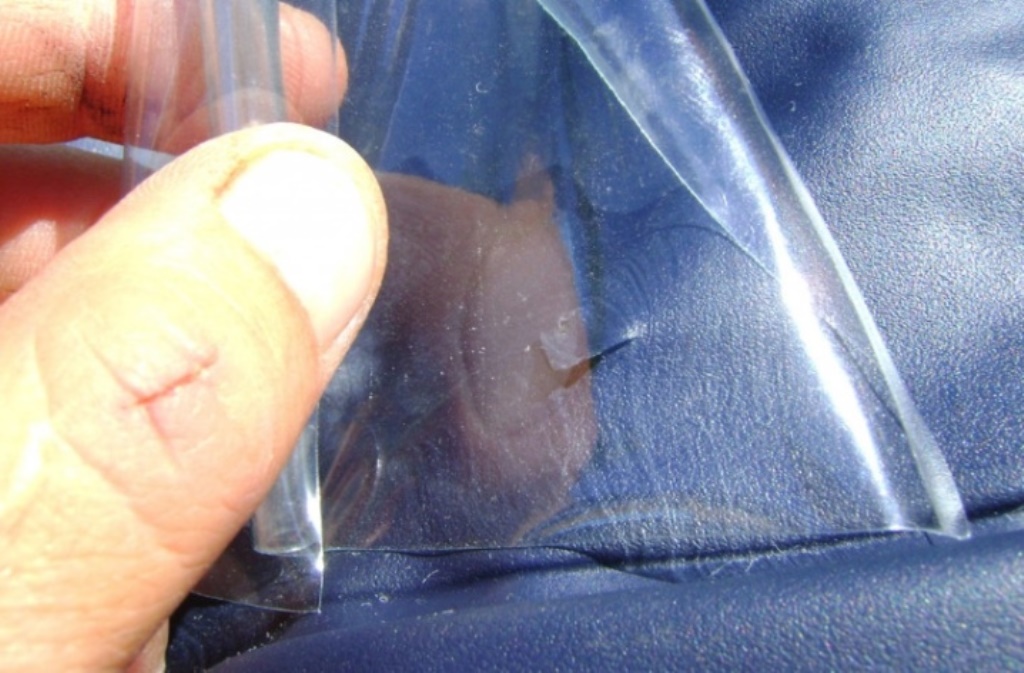
When all preparations are completed, you can begin the repair process:
- Degreased and cleaned surfaces are greased with glue. The brush allows you to apply the adhesive in an even layer.
- Technological time is expected. Evaporating in an open place, the glue activates its beneficial properties. The activation speed is indicated on the tube under the "Method of application" column. Usually the time does not exceed 10 minutes.
- The patch is applied to the damaged area and pressed down. This should be done from the center to the edges. The glue should show through the entire perimeter of the patch.
- The depressed patch is fixed with a weight. Any item exceeding the size of the patch is suitable as a press. If the patch is large, then the pressing weights are laid out along the entire perimeter, if possible, without gaps between adjacent weights.
- After the expiration of the period indicated in the instructions on the tube (a day or two), the goods are removed. The sleeping place can be exploited.

Do-it-yourselfers often neglect the gluing method and try to apply a rubber patch using fire cauterization. Also, amateur craftsmen often try to singe the crumpled material around the hole in the hope of eliminating the puncture. The consequences are usually sad. Only a professional is able to perform such actions correctly.

Seam sealing
When the bedding has a factory seam, the outer patch will not help repair the crumbling mattress. You will have to patch it from the inside. To do this, you need to perform the following actions:
- The valve is disassembled. A hole is formed. In most products, the diameter of the hole allows you to stick your hand inside the mattress.
- The damaged area is pulled through the valve opening with the wrong side out.
- The surface of the site is straightened for gluing. It is recommended to fill the resulting "bag" with rags.Glue that gets through the seam gaps will grab the rag material and will not touch the surface of the bag.
- Patching the seamy area is done according to the same rules as gluing the outer patches. Cleaning, degreasing, gluing, pressing with a load.
- The repaired seam with an internal patch is returned through the flap hole into place. Glued rags are carefully detached. Typically, the adhesion is poor due to the difference in material and the small amount of leaked glue. Problems will arise if the bag is left empty and the glue will bond the outside of the mattress.
- The valve is reinstalled. Air is forced into the compartments. The tightness of the seam is checked.
- For insurance, you can mount an identical patch on the outer section of the seam.

After the mattress has been inflated, the back patch is pressed even more against the seam area, providing it with a better seal. Ordinary injuries could also be repaired in a “purl” manner, while retaining the external aesthetics. However, the process is laborious, and it is easier to eliminate external punctures in simpler ways at home.

How to seal a hole on the velor side
Owners of mattresses often simply do not understand how to glue the mattress from the velor side. The fleecy surface of the velor prevents patching. Before gluing around the puncture, you will have to remove all the pile, leaving only a smooth base. The separation of the pile from the surface is carried out with the help of an adhesive solvent.

You can repair the mattress from the velor side as follows:
- A portion of the adhesive solvent is placed into the syringe.
- An area with a puncture is marked. The border of the area should be 1-2 cm larger than the size of the patch.
- Using a syringe, the solvent is gently distributed over the area. Time is waiting. The reaction rate with the adhesive is indicated on the solvent can.
- The weakened pile layer is cleaned off with a coin or token. It is not advisable to use a knife and sharp tools for stripping.
- The surface is thoroughly wiped from the solvent and dried. It is not necessary to degrease the area, since organics will not have time to take root on an aggressively treated surface.
- A patch is glued, pressed with a load and the time required for the glue to completely harden is waited.

Prevention measures
In most cases, holes in the mattress are the result of careless use. Careless users drop the mattress onto the jagged floor. Rolling children on a mattress on the grass or snow leads to scratching on stones and hitting various pins, nails and sharp parts of brushwood. Pets can sharpen their nails on the mattress. Children often use it as a trampoline, putting excessive stress on the seams. A sleeping item not intended for swimming in water is immersed in water. Finally, the most common mistake made by air mattress owners is pumping air into their compartments. The product receives excessive internal pressure, which leads to rapid wear.
Compliance with basic operating rules will help to avoid many troubles. The inflatable mattress is best stored assembled in a dark and dry place. You cannot accelerate its deflation by pressing. It is strictly forbidden to use abrasive powders and agents with aggressive components when cleaning the mattress. It is much easier to protect the mattress from damage than to patch the punctures later.
Video: how to glue an inflatable mattress from the velor side






